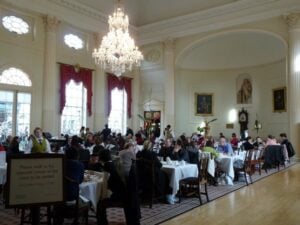
Antique chandeliers first gain a mention around 1700 with the installation of a ‘crystal’ branch at Hampton Court. The first ‘crystal chandeliers’ were metal and wire frames decorated with rock crystal beads and rosettes. It was not until the Georgian era, that developments in glass technology meant an arm could be fashioned from glass that was strong enough to hold some weight. As the designs improved, the crystal chandelier became highly fashionable. Candles and glass were very expensive and highly taxed which made chandeliers the ultimate status symbol.
Social changes meant that the long held tradition of lunchtime dinning was substituted, at least by the upper classes, to evening dinner parties which required lighting. The poor quality of the candle light available made glass and mirrors the perfect addition to increase the light in a glamorous room. A wealthy Georgian homeowner would often burn hundreds of candles during a dinner party, but may well be found reading by a fire and burning a cheaper, tallow candle, once the guests had left!
PARKER AND PERRY AND CANDLE CHANDELIERS
The style and design of crystal chandeliers continued to change with the development of new techniques. By C. 1800, Regency ‘frame’ or ‘tent’ chandeliers became popular. A metal frame supports crystal chains which run the length of the chandelier.
When William Parker was commissioned to make the Tea Room chandeliers at the Bath Assembly Rooms, he introduced vase-shaped stem pieces and neo-classical elements, giving the rather more slender, elegant design we still see today. Antique chandeliers dating from Georgian times are now both rare and extremely valuable. The crystal chandeliers gracing the Bath Assembly Rooms are valued at several million pounds.
